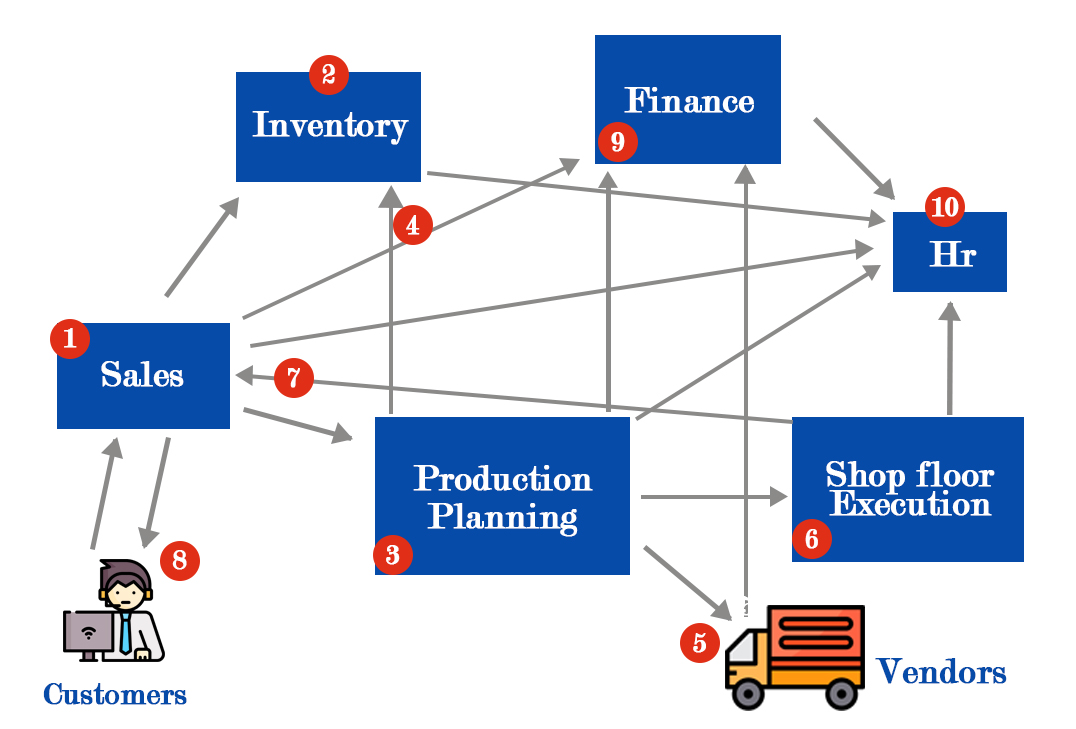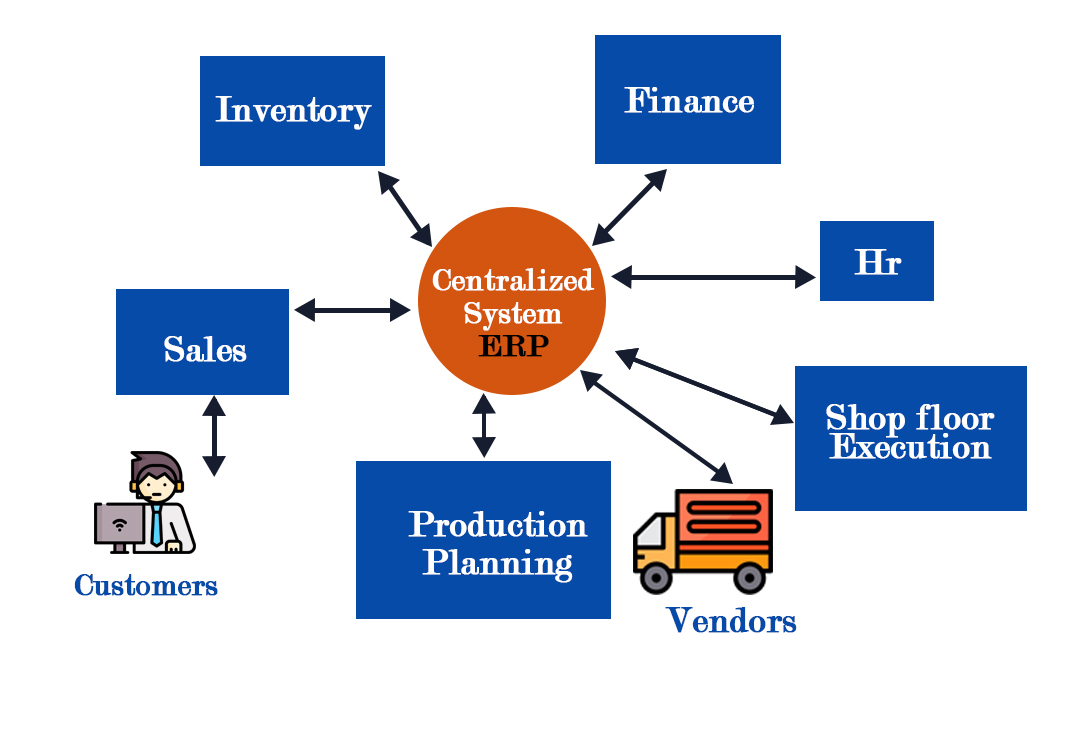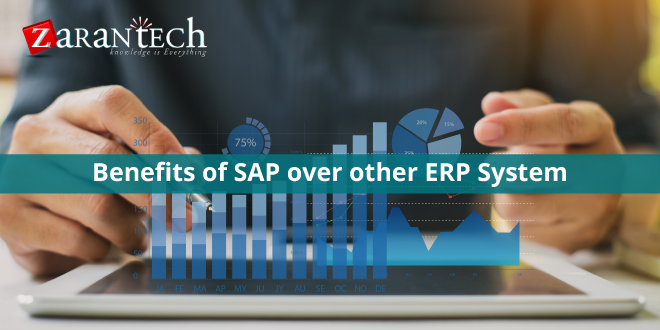What is SAP? Why do we need SAP ERP?
Category: SAP Posted:Dec 20, 2018 By: Serena Josh
Each business holds its objectives and goals, procedures, and requirements. Most importantly, the current businesses require innovative technologies with complete functions that fill the gap between business processes and folks. An organization has several departments and teams, in order to run them successfully; there should be an ERP system that supports them by coordinating all information and communication within the organization. An ERP system is a grouping of software, and the company’s activities carried out to accomplish various operations. An ERP software helps to adjust the entire project value chain and also simplifies the critical processes effectively and efficiently.
Presently, SAP ERP is one of the powerful Enterprise Resource Planning systems. SAP stands for Systems, Applications, and Products in the data processing. In the year 1972, Wellenreuther, Hopp, Hector, Plattner, and Tschira founded SAP software. SAP system includes various integrated modules, which covers almost all the feature of the business management. Since 2010, SAP has more than 140,000 installations globally, over 25 industry-specific business solutions, and more than seventy-five thousand customers in 120 countries.
Need of an ERP system:
Well, any beginner who wants to make a career in SAP ERP is enthusiastic to know about the ERP system, and the very first question which arises to their mind is why an ERP system is required? To answer this question let us consider a scenario:
A customer wants to purchase a specific product. Thus, the contacts the sales department of an enterprise- the sales team’s links with the inventory team to check the product’s availability. But, unfortunately, that product is unavailable and the organization lose the sale. To make sure that this won’t rehash next time; the organizations are using ERP software. Let us see how an ERP system overcomes these issues. But before learning about ERP system let us understand how various departments are involved in the entire business process. The step by step procedure is mentioned below:
1. A customer approaches the sales department to check the product’s availability.
2. Then the sales teams link to the inventory department to check whether the particular product is available or not.
3. If the product is unavailable, the sales team connects to the production planning department and asks them to manufacture the product.
4. Next, the production planning team connects again with the inventory department to check the availability of raw material.
5. If the raw material is unavailable, the production planning team purchases it from the wholesalers.
6. Then the production planning team moves the raw materials to the shop floor execution for the creation of an actual product.
7. Once the product is ready, the shop floor team sends it to the sales team.
8. The sales team, in turn, delivers the specific product to the client.
9. Meanwhile, the sales team informs the finance department regarding the income generated by the sale of the product. Production planning team then update the finance team with payments to be done to different vendors for raw materials.
10. The HR department is also involved in the complete process to take care of any HR related issue.
This is the usual business process that any manufacturing company follows. Below are a few essential points that can be derived from the above scenario:
- A company has different subdivisions or business units.
- These subdivisions or business units communicate with each other continuously and exchange information with each other.
- An organization becomes successful by communicating and transferring data within departments, as well as related third-party such as vendors, clients, etc.
The enterprise can be classified as a decentralized and centralized system as per the communication and data exchanged is accomplished.
Decentralized System: Many companies with decentralized system face several issues such as:
Data is maintained locally at the specific departments and also the departments will not be able to access information and data from other sections.

To know the issue with the decentralized ERP system, let us consider the above business process scenario once again. The customer contacts the sales department to purchase a particular product, but he wants the product urgently. As this is a decentralized process, the sales team doesn’t have any real-time information access related to the availability of the product and therefore connects with the inventory department to check the availability of the product; this process takes a lot of time, and the client looks for another vendor which results in customer disappointment and loss of revenue. If the product is unavailable and the sales team connects with the production planning team to manufacture the product for further use. Production planning team in turn checks for the required raw material. In a distributed system, the production planning and inventory department separately store the information of raw material; this raises the data maintenance cost.
When sales team check for the availability of raw material for a particular product, as per the inventory department it confirms the availability of the product, but at the same time as per the database of the production planning team it shows the product is unavailable. The organization purchases the raw material, but this increase the material and inventory cost. If the raw material is available, but there is a shortage of workers then shop floor team connects with the HR department, who recruit the momentary workers higher than market rates; this increases the cost of labor.
At the same time, the production planning section fails to inform the finance team regarding the material purchasing. Therefore, the finance department delays the payment decided by the vendor; this affects the company’s reputation and also invite probable legal action.
These are the significant issues with the decentralized system. In order to overcome these problems, the organizations are using a centralized system, i.e., ERP.
Centralized System: If a company utilizes a centralized system, the data is preserved at the central location, and it is shared with various departments. Also, the departments can access the information or data of other departments. Let us consider the same business process scenario once more to solve this issue of the decentralized system:
Most of the people still have confusion in moving towards SAP ERP. Here you can understand in a better way- Why do People Want to Get SAP Certification?
All department shares the data or information with the central information system.
- When a client contacts the sales team for purchasing a product, the sales team has real-time information access to the products in inventory which is informed by the inventory team in the centralized system.
- The sales team immediately responds to client requests which results in increased income and customer satisfaction.
- If it is required to manufacture the specific product the sales team updates the centralized database so that all the departments get information about the status of the product.
- Even the production planning team gets an update automatically by the centralized database for requirements. The production planning team checks the availability of the raw materials through the central database.
- This avoids data duplication and provides correct data. The shop floor team is responsible for updating the employee’s status regularly in the central database so that the HR department can access it and can recruit suitable candidates in case of shortage of employees at market price; this lowers the labor cost.
- With the centralized system, the vendors can directly submit their invoices to the central enterprise system; and the finance team can easily access the invoice. Thus, the payments can be done on time and any kind of legal actions are also avoided.

SAP ERP is a type of centralized system which most of the organizations are utilizing currently.
Advantages of Centralized System:
- SAP ERP software is a centralized enterprise management system.
- The centralized system removes the duplication, gaps, and redundancy in data.
- It provides information across all departments in real time.
- SAP ERP system provides control on different business processes.
- The centralized system enhances productivity, provides better inventory management, endorses quality, decreases raw material cost, effective HR management, reduce expenses and enhances profits.
- With a centralized system, the organizations can get better customer communication and thus improves throughput. It also helps to enhance customer service.
An SAP ERP solution involves two types of modules, i.e., Functional and Technical modules, to carry out transactions which help to execute essential business processes. SAP has around 25 modules; however, all the 25 SAP modules are not applied. The most implemented modules are the most successful and have the highest job opportunities. Such important SAP Modules utilized by numerous organizations are as follows:
- FICO- Finance & Control
- PP- Production Planning
- MM- Material Management
- SD- Sales & Distribution
- HR- Human Resources
- CRM- Customer Relationship Management
- ABAP- Advanced Business Application Management
- XI- Exchange Infrastructure
- Net Viewer
- Basis
- BIW- Business Information Warehousing
Conclusion:
Nowadays, businesses wish to implement an ERP system as they want to enhance the internal business processes and overall business performance. An SAP ERP system helps to reduce the companies’ labor costs, IT expenses, also it improves interactions between various departments and teams, avoids data duplication. Even an ERP system helps to make the payments on time which in turn prevents the company from probable legal actions.
For more such informative and engaging articles on SAP feel free to visit our website. Also, at ZaranTech we offer self-paced online training on Workday HCM and various other Workday, SAP topics. To learn more about our courses, please visit our website.




 99999999 (Toll Free)
99999999 (Toll Free)  +91 9999999
+91 9999999